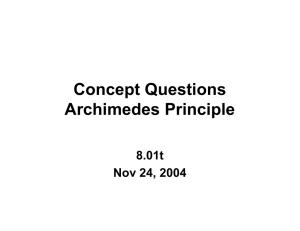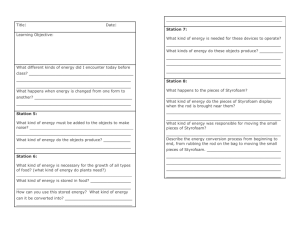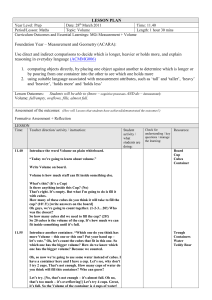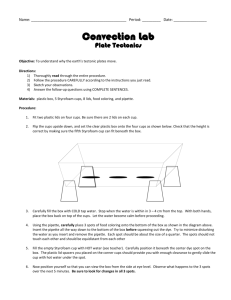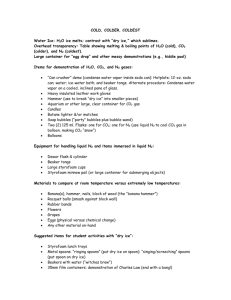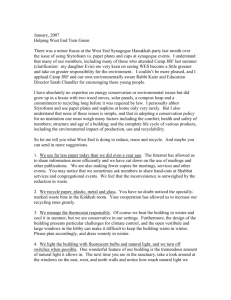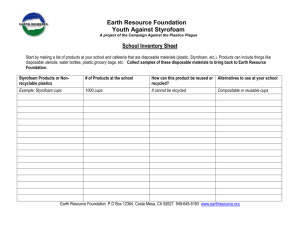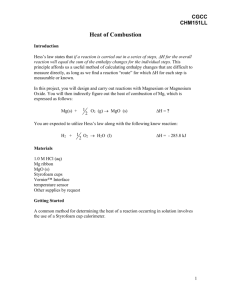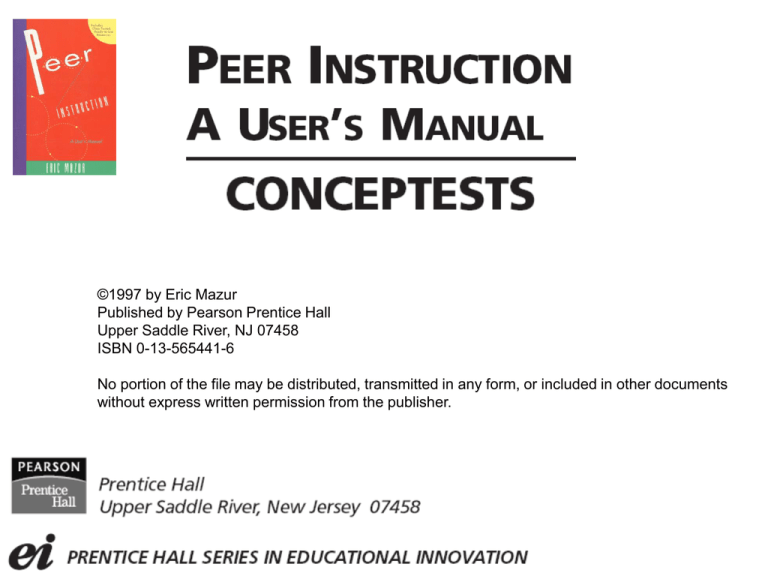
©1997 by Eric Mazur
Published by Pearson Prentice Hall
Upper Saddle River, NJ 07458
ISBN 0-13-565441-6
No portion of the file may be distributed, transmitted in any form, or included in other documents
without express written permission from the publisher.
Fluid Statics
Imagine holding two bricks under water. Brick A is just
beneath the surface of the water, while brick B is at a greater
depth. The force needed to hold brick B in place is
1. larger
2. the same as
3. smaller
than the force required to hold brick A in place.
When a hole is made in the side of a container holding water,
water flows out and follows a parabolic trajectory. If the
container is dropped in free fall, the water flow
1. diminishes.
2. stops altogether.
3. goes out in a straight line.
4. curves upward.
A container is filled with oil and fitted on both ends with
pistons. The area of the left piston is 10 mm2; that of the right
piston 10,000 mm2. What force must be exerted on the left
piston to keep the 10,000-N car on the right at the same
height?
1. 10 N
2. 100 N
3. 10,000 N
4. 106 N
5. 108 N
6. insufficient information
A 200-ton ship enters the lock of a canal. The fit between the
sides of the lock and the ship is tight so that the weight of the
water left in the lock after it closes is much less than 200
tons. Can the ship still float if the quantity of water left in the
lock is much less than the ship’s weight?
1. Yes, as long as the water gets up to the ship’s waterline.
2. No, the ship touches bottom because it weighs more than
the water in the lock.
Two cups are filled to the same level with water. One of the
two cups has ice cubes floating in it. Which weighs more?
1. The cup without ice cubes.
2. The cup with ice cubes.
3. The two weigh the same.
Two cups are filled to the same level with water. One of the
two cups has ice cubes floating in it. When the ice cubes
melt, in which cup is the level of the water higher?
1. The cup without ice cubes.
2. The cup with ice cubes.
3. It is the same in both.
Two cups are filled to the same level with water. One of the
two cups has plastic balls floating in it. If the density of the
plastic balls is less than that of ice, which of the two cups
weighs more?
1. The cup without plastic balls.
2. The cup with plastic balls.
3. The two weigh the same.
A lead weight is fastened on top of a large solid piece of
Styrofoam that floats in a container of water. Because of the
weight of the lead, the water line is flush with the top surface
of the Styrofoam. If the piece of Styrofoam is turned upside
down so that the weight is now suspended underneath it,
1. the arrangement sinks.
2. the water line is below the top surface of the Styrofoam.
3. the water line is still flush with the top surface of the
Styrofoam.
A lead weight is fastened to a large solid piece of Styrofoam
that floats in a container of water. Because of the weight of
the lead, the water line is flush with the top surface of the
Styrofoam. If the piece of Styrofoam is turned upside down,
so that the weight is now suspended underneath it, the water
level in the container
1. rises.
2. drops.
3. remains the same.
A boat carrying a large boulder is floating on a lake. The
boulder is thrown overboard and sinks. The water level in the
lake (with respect to the shore)
1. rises.
2. drops.
3. remains the same.
Consider an object that floats in water but sinks in oil. When
the object floats in water, half of it is submerged. If we slowly
pour oil on top of the water so it completely covers the object,
the object
1. moves up.
2. stays in the same place.
3. moves down.
Consider an object floating in a container of water. If the
container is placed in an elevator that accelerates upward,
1. more of the object is below water.
2. less of the object is below water.
3. there is no difference.
A circular hoop sits in a stream of water, oriented
perpendicular to the current. If the area of the hoop is
doubled, the flux (volume of water per unit time) through it
1. decreases by a factor of 4.
2. decreases by a factor of 2.
3. remains the same.
4. increases by a factor of 2.
5. increases by a factor of 4.
Blood flows through a coronary artery that is partially blocked
by deposits along the artery wall. Through which part of the
artery is the flux (volume of blood per unit time) largest?
1. The narrow part.
2. The wide part.
3. The flux is the same in both parts.
Blood flows through a coronary artery that is partially blocked
by deposits along the artery wall. Through which part of the
artery is the flow speed largest?
1. The narrow part.
2. The wide part.
3. The flux is the same in both parts.
Two hoses, one of 20-mm diameter, the other of 15-mm
diameter are connected one behind the other to a faucet. At
the open end of the hose, the flow of water measures 10
liters per minute. Through which pipe does the water flow
faster?
1. the 20-mm hose
2. the 15-mm hose
3. The flow rate is the same in both cases.
4. The answer depends on which of the two hoses comes
first in the flow.
A blood platelet drifts along with the flow of blood through an
artery that is partially blocked by deposits. As the platelet
moves from the narrow region to the wider region, its speed
1. increases.
2. remains the same.
3. decreases.
A blood platelet drifts along with the flow of blood through an
artery that is partially blocked by deposits. As the platelet
moves from the narrow region to the wider region, it
experiences
1. an increase in pressure.
2. no change in pressure.
3. a decrease in pressure.

![[] Chapter 14b](http://s2.studylib.net/store/data/010138698_1-4a99a58035d5c4440203de4bd1c46d57-300x300.png)
